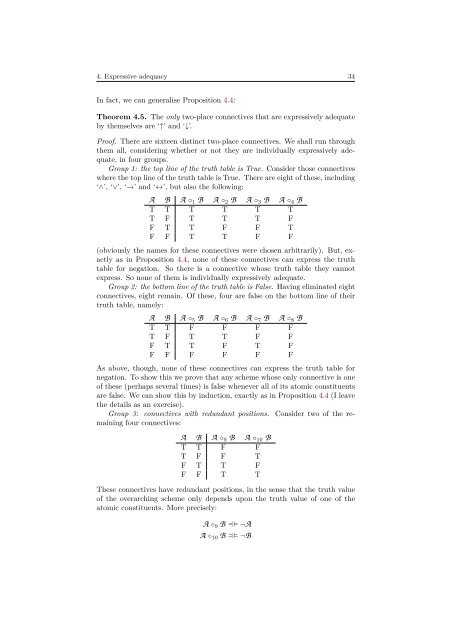Metatheory - University of Cambridge
Metatheory - University of Cambridge
Metatheory - University of Cambridge
Create successful ePaper yourself
Turn your PDF publications into a flip-book with our unique Google optimized e-Paper software.
4. Expressive adequacy 34<br />
In fact, we can generalise Proposition 4.4:<br />
Theorem 4.5. The only two-place connectives that are expressively adequate<br />
by themselves are ‘↑’ and ‘↓’.<br />
Pro<strong>of</strong>. There are sixteen distinct two-place connectives. We shall run through<br />
them all, considering whether or not they are individually expressively adequate,<br />
in four groups.<br />
Group 1: the top line <strong>of</strong> the truth table is True. Consider those connectives<br />
where the top line <strong>of</strong> the truth table is True. There are eight <strong>of</strong> these, including<br />
‘∧’, ‘∨’, ‘→’ and ‘↔’, but also the following:<br />
A B A ◦ 1 B A ◦ 2 B A ◦ 3 B A ◦ 4 B<br />
T T T T T T<br />
T F T T T F<br />
F T T F F T<br />
F F T T F F<br />
(obviously the names for these connectives were chosen arbitrarily). But, exactly<br />
as in Proposition 4.4, none <strong>of</strong> these connectives can express the truth<br />
table for negation. So there is a connective whose truth table they cannot<br />
express. So none <strong>of</strong> them is individually expressively adequate.<br />
Group 2: the bottom line <strong>of</strong> the truth table is False. Having eliminated eight<br />
connectives, eight remain. Of these, four are false on the bottom line <strong>of</strong> their<br />
truth table, namely:<br />
A B A ◦ 5 B A ◦ 6 B A ◦ 7 B A ◦ 8 B<br />
T T F F F F<br />
T F T T F F<br />
F T T F T F<br />
F F F F F F<br />
As above, though, none <strong>of</strong> these connectives can express the truth table for<br />
negation. To show this we prove that any scheme whose only connective is one<br />
<strong>of</strong> these (perhaps several times) is false whenever all <strong>of</strong> its atomic constituents<br />
are false. We can show this by induction, exactly as in Proposition 4.4 (I leave<br />
the details as an exercise).<br />
Group 3: connectives with redundant positions. Consider two <strong>of</strong> the remaining<br />
four connectives:<br />
A B A ◦ 9 B A ◦ 10 B<br />
T T F F<br />
T F F T<br />
F T T F<br />
F F T T<br />
These connectives have redundant positions, in the sense that the truth value<br />
<strong>of</strong> the overarching scheme only depends upon the truth value <strong>of</strong> one <strong>of</strong> the<br />
atomic constituents. More precisely:<br />
A ◦ 9 B<br />
A ◦ 10 B<br />
⊨<br />
⊨<br />
⊨ ¬A<br />
⊨ ¬B
















